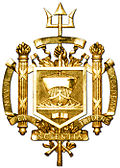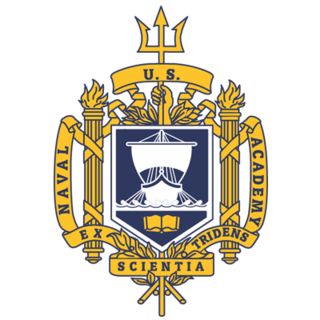
The United States Naval Academy is a federal service academy in Annapolis, Maryland. It was established on 10 October 1845 during the tenure of George Bancroft as Secretary of the Navy. The Naval Academy is the second oldest of the five U.S. service academies and it educates midshipmen for service in the officer corps of the United States Navy and United States Marine Corps. The 338-acre (137 ha) campus is located on the former grounds of Fort Severn at the confluence of the Severn River and Chesapeake Bay in Anne Arundel County, 33 miles (53 km) east of Washington, D.C., and 26 miles (42 km) southeast of Baltimore. The entire campus, known colloquially as the Yard, is a National Historic Landmark and home to many historic sites, buildings, and monuments. It replaced Philadelphia Naval Asylum in Philadelphia that had served as the first United States Naval Academy from 1838 to 1845 when the Naval Academy formed in Annapolis.
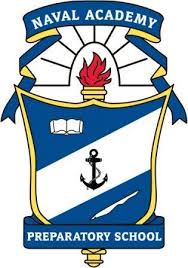
The Naval Academy Preparatory School or NAPS is the preparatory school for the United States Naval Academy (USNA). NAPS is located on Naval Station Newport, Rhode Island. The mission of the Naval Academy Preparatory School is "To enhance Midshipman Candidates' moral, mental, and physical foundations to prepare them for success at the United States Naval Academy".

The Commander-in-Chief's Trophy is awarded to each season's winner of the American college football series among the teams of the U.S. Military Academy, the U.S. Naval Academy, and the U.S. Air Force Academy.

The United States Naval Academy Cemetery and Columbarium is a cemetery at the United States Naval Academy in Annapolis, Maryland.
Bill the Goat is the mascot of the United States Naval Academy. The mascot is a live goat and is also represented by a costumed midshipman. There is also a bronze statue of the goat in the north end zone of Navy–Marine Corps Memorial Stadium. This statue also plays a role in "Army Week" traditions.

Robert Means Thompson Stadium was an American football stadium in the eastern United States, located on the campus of the United States Naval Academy in Annapolis, Maryland. Constructed in 1914, it was the home stadium of the Navy Midshipmen from 1924 through 1958, and was named after alumnus Robert Means Thompson (1849–1930). He created or led several athletically-based organizations at the academy until his death. It was succeeded by the larger Navy–Marine Corps Memorial Stadium in 1959, the current venue of Navy football.

The United States Naval Academy Chapel in Annapolis, Maryland, is one of nine designated chapel spaces on the grounds of the United States Navy's service academy. Protestant and Catholic services are held there. The Brigade Chapel is a focal point of the Academy and the city of Annapolis. The chapel is an important feature which led to the Academy being designated a National Historic Landmark in 1961.

The Navy Midshipmen are the athletic teams that represent the United States Naval Academy. The academy sponsors 36 varsity sports teams and 12 club sport teams. Both men's and women's teams are called Navy Midshipmen or "Mids". They participate in the NCAA's Division I, as a non-football member of the Patriot League, a football-only member of the American Athletic Conference in the Football Bowl Subdivision (FBS), and a member of the Collegiate Sprint Football League (men), Eastern Association of Rowing Colleges (men), Eastern Association of Women's Rowing Colleges, Eastern Intercollegiate Gymnastics League (men), Mid-Atlantic Squash Conference (men) and Eastern Intercollegiate Wrestling Association. Navy is also one of approximately 300 members of the Eastern College Athletic Conference (ECAC).

Induction Day or I-Day is the official name for the first day of Plebe Summer at the United States Naval Academy. Typically held in late June or early July, this is the day on which the members of the newest Naval Academy class arrive in Annapolis; for most, it is also their first day in the military.

The Navy Midshipmen men's basketball team represents the United States Naval Academy, in Annapolis, Maryland, in NCAA Division I college basketball. The team competes in the Patriot League and plays its home games in Alumni Hall.
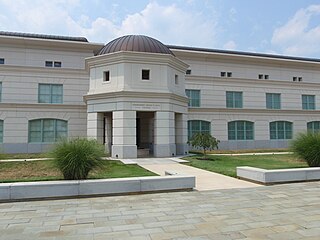
Commodore Uriah P. Levy Center and Jewish Chapel is the Jewish chapel at the United States Naval Academy, in Annapolis, Maryland.
The Honor Concept and Honor Treatise are parts of the United States Naval Academy's Honor Program. Similar to the Cadet Honor Codes of the United States Military Academy and United States Air Force Academy, the Concept formalizes the requirement for midshipmen to demonstrate integrity while refusing to lie, cheat or steal.

Halsey Field House is a multi-purpose arena at the United States Naval Academy, in Annapolis, Maryland, with a seating capacity of 5,000. It was home to the Navy Midshipmen men's basketball team until the Alumni Hall opened in 1991. It is named after William Halsey Jr., a World War II United States Navy commander.

The Wesley Brown Field House is a sports arena at the United States Naval Academy in Annapolis, Maryland. It is located between the 7th Wing of Bancroft Hall and Santee Basin. The 140,000-square-foot (13,000 m2) facility houses physical education, varsity sports, club sports, and personal-fitness programs and equipment. It is home to the Midshipmen women's volleyball team, men's and women's indoor track and field teams, men's wrestling, women’s lacrosse team and sixteen club sports. It also serves as the practice space for the football and women's volleyball teams. There is also a centralized sports-medicine facility. The building has a total room area of 5,800 square feet (540 m2), eight locker rooms, and 300 lockers.

USNA Out is an American non-profit organization of lesbian, gay, bisexual and transgender (LGBT) Alumni of the U. S. Naval Academy in Annapolis, Maryland. USNA Out is an independent 501(c)(3) organization that does not represent the Naval Academy Alumni Association nor the U. S. Naval Academy. USNA Out is the first LGBT organization representing alumni from a federal service academy.
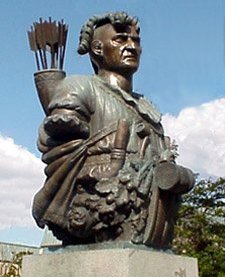
Tamanend was honored as the figurehead of USS Delaware in a carving by William Luke. Tamanend the “affable” was a chief of one of the clans that made up the Lenni-Lenape nation in the Delaware Valley. He is best known as a lover of peace and friendship who played a prominent role in the establishment of peaceful relations among the Native American tribes and the English settlers who established Pennsylvania, led by William Penn.
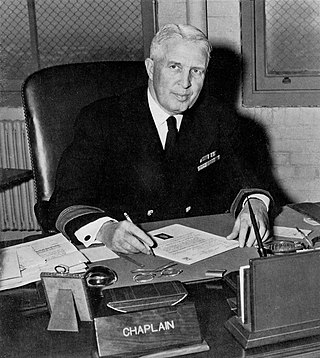
William Nathaniel Thomas was a US Navy chief of chaplains, described by one historian as "one of the most distinguished Chaplains ever to serve in the US Navy." Born in Mississippi and entering the navy in 1918, he became a rear admiral and was a chief of chaplains of the United States Navy (1945–1949). He was chaplain aboard the USS Madawaska, a World War I troop transport. He then served on the USS Pennsylvania, the USS Raleigh and the USS West Virginia. He served at the United States Naval Academy in Annapolis, Maryland, as an assistant chaplain and then as command chaplain. He wrote the Prayer of the Midshipman and the Dedication in Memorial Hall at the Naval Academy.
The "Prayer of a Midshipman" was written by William Nathaniel Thomas in 1938. Thomas (1892-1979) was the Chief of Chaplains of the United States Navy. He wrote the "Prayer of a Midshipman" at the request of the midshipmen while Command Chaplain at the United States Naval Academy, Annapolis, Maryland. It is said to encompass much of his theology and his ideal of a Naval Officer." He never sought credit for the prayer. There is an original version and an ungendered interfaith version. The prayer has been used at Divine Services at the US Naval Academy Chapel ever since 1938. A bronze plaque of the prayer resides in the chapel. During Plebe summer 2013 the US Naval Academy Chaplain Center conducted a Midshipman Prayer Sermon Series. “Each Sunday during the Plebe Summer of 2013, the preacher for that week addressed one of the petitions of the Midshipman Prayer. The scripture readings were specially selected to complement and expand on the petition rather than follow the traditional Revised Common Lectionary.”

Lejeune Hall is a sports complex and arena at the United States Naval Academy in Annapolis, Maryland. It currently houses the academy's boxing and wrestling practice arena, and natatorium, and the Naval Academy's Athletic Hall of Fame.

The United States Naval Academy Drum and Bugle Corps is the military band and drum and bugle corps of the United States Naval Academy, which is a federal service academy in the United States Armed Forces based Maryland. Like its counterpart at the Air Force Academy, it is staffed by midshipmen from the Brigade of Midshipmen. It provides support to the brigade as well as the Plebe Summer Regiment. Until the addition of woodwinds in June 2021, it was the oldest continuously active drum and bugle corps in the United States. It currently performs over 70 times per year.























